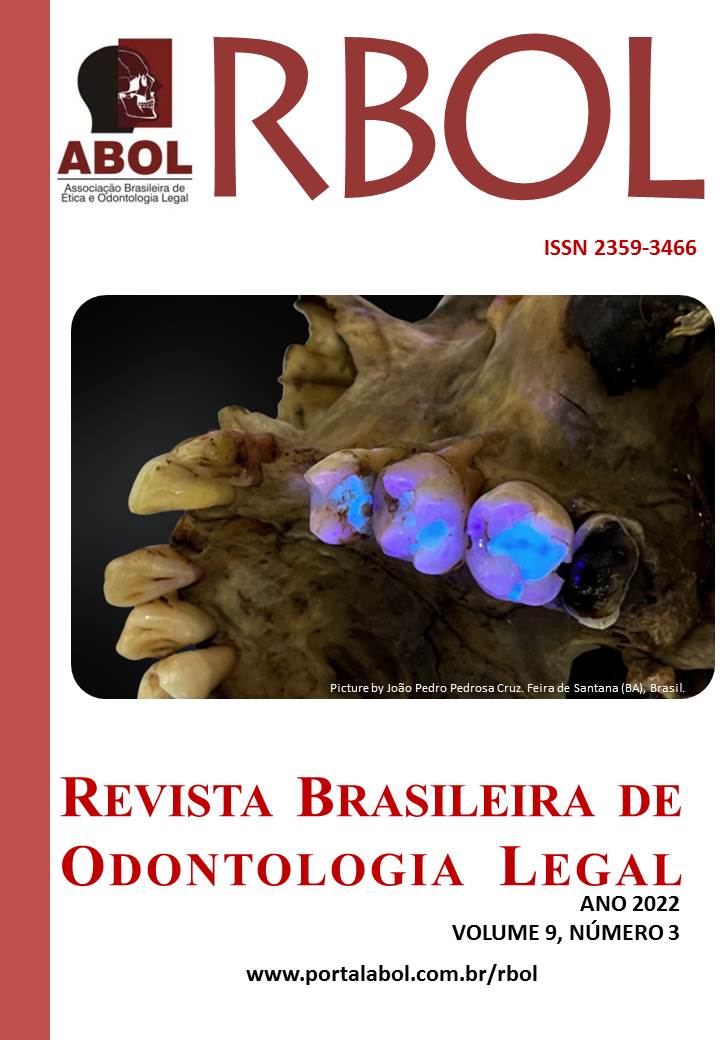ANALYSIS OF THE ANTHROPOMETRIC MEASUREMENTS OF THE SMILE USING 3D STEREOPHOTOGRAMMETRY
DOI:
https://doi.org/10.21117/rbol-v9n32022-473Palavras-chave:
Stereophotogrammetry. Human Identification. Forensic Odontology. Smile.Resumo
3D stereophotogrammetry makes the analysis of facial soft tissues possible, and has the potential to contribute to human identification processes. Nowadays, the images available through social networks are composed of a significant amount of smile photos, making techniques such as 3D stereophotogrammetry relevant. The objective of the present study was to quantitatively analyze the anthropometric measurements of the smile through 3D stereophotogrammetry, including area, angular, and linear measurements. Anatomical landmarks were used to make possible the area, angular, and linear measurements. The sample consisted of 25 volunteers, 13 female and 12 male, both in the 19-25 age group, resulting in a mean age of 22.3±1.9 and 23.3±1.5, respectively. The anatomical landmarks were marked on the face of the volunteers using a black eyeliner, and the photographs were taken using the 3D stereophotogrammetry technique (Vectra H1, Canfield, NY, USA), being 3 photographs with a spontaneous smile and 3 at rest, right lateral, left lateral and frontal of each. Among the results of the comparison between genders and the photo/smile relation of the statistical analysis, variables such as the mentolabial angle and the vermilion height of the upper lip showed significant p-values of 0.046 and 0.014, respectively. It can be concluded that anthropometric measurements of three-dimensional smile images can be performed with the use of 3D stereophotogrammetry, with the purpose of contributing to facial identification methods.
Downloads
Publicado
Edição
Seção
Licença
Os autores deverão encaminhar por email, devidamente assinada pelos autores ou pelo autor responsável pelo trabalho, a declaração de responsabilidade e transferência de direitos autorais para a RBOL, conforme modelo abaixo.
DECLARAÇÃO DE RESPONSABILIDADE E TRANSFERÊNCIA DE DIREITOS AUTORAIS
Eu (Nós), listar os nomes completos dos autores, transfiro(rimos) todos os direitos autorais do artigo intitulado: colocar o título à Revista Brasileira de Odontologia Legal - RBOL.
Declaro(amos) que o trabalho mencionado é original, não é resultante de plágio, que não foi publicado e não está sendo considerado para publicação em outra revista, quer seja no formato impresso ou no eletrônico.
Declaro(amos) que o presente trabalho não apresenta conflitos de interesse pessoais, empresariais ou governamentais que poderiam comprometer a obtenção e divulgação dos resultados bem como a discussão e conclusão do estudo.
Declaro(amos) que o presente trabalho foi totalmente custeado por seus autores. Em caso de financiamento, identificar qual a empresa, governo ou agência financiadora.
Local, data, mês e ano.
Nome e assinatura do autor responsável (ou de todos os autores).

